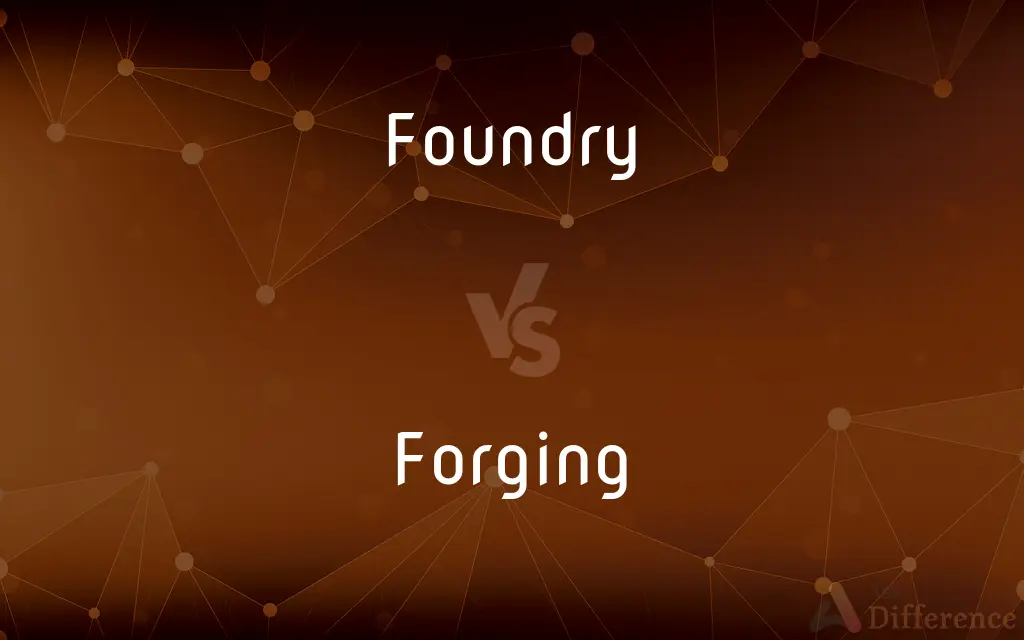Foundry vs. Forging — What's the Difference?
By Maham Liaqat & Fiza Rafique — Updated on March 10, 2024
Foundries melt and cast metal into shapes; forging deforms metal into shape through force.

Difference Between Foundry and Forging
Table of Contents
ADVERTISEMENT
Key Differences
Foundries specialize in melting metals and casting them into various shapes by pouring the molten metal into molds. This process allows for complex geometries and detailed designs, making it ideal for producing a wide range of products, from engine blocks to intricate jewelry. Whereas forging involves the shaping of metal using localized compressive forces, such as hammering or pressing, this method imparts unique mechanical properties to the metal, such as increased toughness and grain refinement, which are beneficial for applications requiring high strength and durability.
The materials used in foundries and forging processes can overlap, such as iron, steel, and aluminum; however, the choice of process might depend on the desired properties of the final product. While foundries can work with a broader range of materials because the casting process can accommodate metals with higher melting points, forging is often limited to metals that can withstand the deformation process without cracking.
Foundries often require significant investments in equipment for melting and mold making, leading to higher production costs for small batches. On the other hand, forging can be more cost-effective for producing small to medium quantities of items, as the process requires less material preparation and can achieve near-net-shape results, reducing waste and further processing.
The environmental impact of both processes varies; foundries emit pollutants from melting metals and can generate hazardous wastes from used molds and cores. Forging, while also energy-intensive, typically has a smaller environmental footprint since it does not involve melting metals and can achieve more material-efficient designs.
Quality control in foundries focuses on the precision of the molds and the purity of the metal to prevent defects such as porosity or inclusions. In forging, the emphasis is on controlling the deformation process to ensure uniform material properties and to avoid defects like cracks or incomplete filling.
ADVERTISEMENT
Comparison Chart
Process
Melting metal and casting into molds
Deforming metal into shape through force
Materials
Broader range, including high melting point metals
Mostly metals that can be deformed without cracking
Production Costs
Higher for small batches due to equipment
Lower for small to medium batches, less material waste
Environmental Impact
Higher due to pollutants from melting, waste
Lower, more material-efficient, no melting involved
Quality Control
Focus on mold precision, metal purity
Focus on deformation control, uniform material properties
Compare with Definitions
Foundry
A place where metals are melted and cast into shapes.
The bronze statue was crafted in a local foundry.
Forging
The process of shaping metal by heating and hammering.
Forging steel requires both precision and strength.
Foundry
The process of casting metal.
Foundry techniques have evolved significantly over the centuries.
Forging
The industry focused on shaping metal parts.
The forging industry plays a critical role in automotive manufacturing.
Foundry
Related to the creation of metal castings.
His skills in foundry work were unparalleled.
Forging
Refers to the action of making or crafting by hand.
Forging a connection with local artisans can enrich your understanding of their craft.
Foundry
A business involved in casting metal.
The foundry has been family-owned for generations.
Forging
A method of metalworking that enhances strength.
Forging the sword imbued it with exceptional durability.
Foundry
The building or factory where casting is done.
The old foundry has been converted into an art space.
Forging
Creating objects from metal through deformation.
The blacksmith excels in forging unique tools.
Foundry
A foundry is a factory that produces metal castings. Metals are cast into shapes by melting them into a liquid, pouring the metal into a mold, and removing the mold material after the metal has solidified as it cools.
Forging
Forging is a manufacturing process involving the shaping of metal using localized compressive forces. The blows are delivered with a hammer (often a power hammer) or a die.
Foundry
An establishment where metal objects are made by melting metal and pouring it into molds.
Forging
A furnace or hearth where metals are heated or wrought; a smithy.
Foundry
The skill or operation of founding.
Forging
A workshop where pig iron is transformed into wrought iron.
Foundry
The castings made by founding.
Forging
To form (metal, for example) by heating in a forge and beating or hammering into shape.
Foundry
A facility that melts metals in special furnaces and pours the molten metal into molds to make products. Foundries are usually specified according to the type of metal dealt with: iron foundry, brass foundry, etc.
Forging
To form (metal) by a mechanical or hydraulic press.
Foundry
The act, process, or art of casting metals; founding.
Forging
To give form or shape to, especially by means of careful effort
Forge a treaty.
Forge a close relationship.
Foundry
A plant that produces chips out of semiconductors in the microelectronics industry.
Forging
To fashion or reproduce for fraudulent purposes; counterfeit
Forge a signature.
Foundry
The act, process, or art of casting metals.
Forging
To work at a forge or smithy.
Foundry
The buildings and works for casting metals.
Forging
To make a forgery or counterfeit.
Foundry
Factory where metal castings are produced
Forging
To advance gradually but steadily
Forged ahead through throngs of shoppers.
Forging
To advance with an abrupt increase of speed
Forged into first place with seconds to go.
Forging
Present participle of forge
Forging
The process of shaping by heating and hammering.
Forging
(countable) A component that is forged shaped by heating and hammering.
Forging
The act of shaping metal by hammering or pressing.
Forging
The act of counterfeiting.
Forging
A piece of forged work in metal; - a general name for a piece of hammered iron or steel.
There are very few yards in the world at which such forgings could be turned out.
Forging
Shaping metal by heating and hammering
Common Curiosities
Which is more environmentally friendly, foundry or forging?
Forging tends to be more environmentally friendly than foundries because it does not involve melting metals, which can emit pollutants and create waste.
What is forging?
Forging is a manufacturing process where metal is shaped by applying localized compressive forces, such as hammering or pressing.
What is a foundry?
A foundry is a workshop or factory where metals are melted and cast into various shapes by pouring the molten metal into molds.
How do foundries and forging processes differ in terms of materials used?
Foundries can handle a wider range of materials, including those with high melting points, while forging is suitable for metals that can endure deformation without cracking.
Can both foundry and forging techniques be used for the same materials?
Yes, many metals can be both cast in foundries and forged, but the choice of process depends on the desired properties and application of the final product.
Which process is more suitable for producing complex shapes?
Foundries are more suitable for complex shapes due to the versatility of casting molds.
What is the primary focus of quality control in a foundry?
Quality control in foundries focuses on mold precision and the purity of the metal to avoid casting defects.
Why might a manufacturer choose forging over casting?
A manufacturer might choose forging for its superior mechanical properties, especially for parts that require high strength and durability.
What is the primary focus of quality control in forging?
In forging, quality control emphasizes the control of deformation to ensure uniform material properties and prevent defects.
What are the environmental concerns associated with foundries?
Environmental concerns include emissions from melting metals and waste from used molds and cores.
How do production costs compare between foundries and forging?
Foundries often have higher production costs for small quantities, while forging can be more cost-effective for small to medium batches.
Is forging stronger than casting?
Forged parts generally have better mechanical properties, such as strength and toughness, compared to cast parts due to the grain refinement and flow lines that result from the deformation process.
Are foundry products more expensive than forged products?
The cost depends on the quantity and specific requirements of the parts; foundry products can be more expensive for small batches due to higher setup costs.
How does the forging process affect the metal's properties?
Forging affects the metal's properties by increasing its strength, toughness, and durability through grain refinement and the orientation of the grain flow.
Can forging be done at room temperature?
Yes, certain metals can be forged at room temperature, a process known as cold forging, which is used for smaller, less complex items.
Share Your Discovery

Previous Comparison
Uncertainty vs. Insecurity
Next Comparison
Commander vs. CaptainAuthor Spotlight
Written by
Maham LiaqatCo-written by
Fiza RafiqueFiza Rafique is a skilled content writer at AskDifference.com, where she meticulously refines and enhances written pieces. Drawing from her vast editorial expertise, Fiza ensures clarity, accuracy, and precision in every article. Passionate about language, she continually seeks to elevate the quality of content for readers worldwide.















































